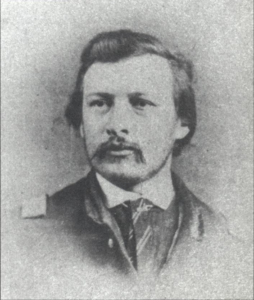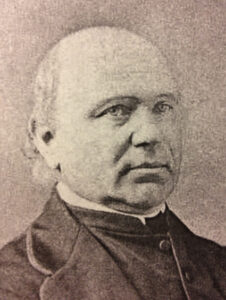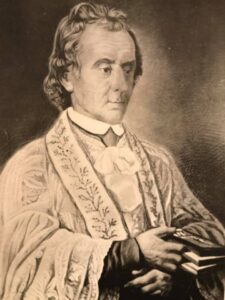Tales from a Monk in the Union Army: A Solitary Monk
By November 1864, the St. Vincent monks—once united under the banner of the 61st Pennsylvania—now found themselves separated. Brother Bonaventure Gaul was the only one that remained with the regiment, serving as a nurse in the Sheridan field hospital in Winchester, Virginia. Brother Ildephonse Hoffmann, Gaul’s close confidante, fell ill that autumn and suffered a head injury, which prompted his transfer to the Soldier’s Home in Elmira, New York.[1] Brother Leo Christ suffered a wound in the Siege of Petersburg and received a thirty-day furlough to return to Latrobe. Brother Ulrich Barth remained in Petersburg while Br. Gallus Maier was transferred to the Second Division hospital of the VI Corps, about twenty miles from the Sheridan field hospital.[2] “It is amazing how we five Brothers are so scattered,” Gaul wrote.[3]
Despite these challenges, Gaul continued to perform his duty by tending to the sick and wounded. He, too, suffered recurrent sickness throughout the course of the winter and witnessed the death of many comrades.[4] “Our regiment is small,” he wrote on November 21, 1864, lamenting that the 61st Pennsylvania had dwindled to only 170 men from the carnage of the recent Shenandoah Valley campaign. Now it contained “only four companies, no flag, no colonel, [and] just two captains.”[5] After Capt. Lewis Redenback of Gaul’s Company B died of his wounds from the battle of Summit Point in September 1864, Sgt. Casper Kauffman was promoted to second lieutenant to lead the company, which was also consolidated with Company K.[6] Desertion had also dwindled the regiment’s ranks. Gaul noted in a letter to Br. Ulrich Barth that five men from Company B deserted—including a man named Eisenhut, whom the brothers knew. Eisenhut was discovered by the regiment’s pickets and executed.

As the war persisted, though, Gaul grew increasingly disillusioned with it. As Abraham Lincoln secured a second term, the young monk feared how “the proud American people would allow so much, namely a President with more power than a Kaiser.”[7] Many American Catholics were wary of the Republican Party because of its ties to nativism and classical liberalism, which they perceived to be a threat to the Roman Catholic faith. Anti-war Catholics also generally opposed Lincoln’s broad interpretation of executive and congressional power, which produced the Conscription Act of 1863.[8] “The future does not look good,” Gaul wrote his friend, “we must resign ourselves to God’s holy will, that makes all things right.”[9]
However, much of Gaul’s trepidation during the war appears to be rooted in the absence of any consistent correspondence from Saint Vincent and Abbot Boniface Wimmer. “The abbot does not let himself be heard from,” he wrote in 1864. “[He] thinks it wonderful what he has already done in that he has brought us free from [serving under] arms.” Unbeknownst to Gaul, Wimmer made two trips to Washington to try and relieve the monks from service, but to no avail.[10]
In fact, Gaul and his brothers relied on other allies like Jesuit priest Fr. Bernardin F. Wiget and Swiss-born Fr. Mathias Alig, who took on the task of lobbying the United States government on St. Vincent’s behalf. Wiget, pastor of St. Aloysius church and president of Gonzaga College in Washington, D.C., wrote on behalf of Hoffmann to prove his legitimacy as a member of the Benedictine Order. Meanwhile, Fr. Alig—the pastor of St. Mary Mother of God parish in Washington—persistently sought to obtain freedom for all the serving brothers of Saint Vincent.[11]

Alig wrote to Secretary of State William Seward on January 16, 1865, requesting that the brothers be permitted to return “to their monastery and let them send to God, the ruler of all nations, their prayers for the protection and success of our Government.” He explained that the brothers had planned to put together their soldiers’ salaries to free just one monk. Alig suspected that it would be Gaul, who, he professed to Seward, desired to return to St. Vincent and “prepare himself to die.” However, the priest likely overstated Gaul’s condition as a rhetorical strategy. Though Gaul was ill throughout the winter of 1864-1865, he gave no indication that he was near death in any of his letters. Regardless, Alig echoed Wimmer’s argument that the brothers made better monks than soldiers. “I am sure that their prayers will be infinitely more advantageous to our government than their service as sick and invalid soldiers,” he wrote Secretary Seward.[12]
Despite the efforts of Wiget and Alig, Gaul still persistently blamed Wimmer for the monks’ predicament. “Since June I have written no letter to the Abbot, and also since June I have received none from him,” he professed. “A person must understand what a raw life a soldier has, and what danger,” the young monk wrote to his friends. “I have gone through more than 30 battles, which were terrifying. But God and the dear Mother Mary protected me, [or] I would surely no longer be alive.” [13] Yet Gaul directed much of his anger toward his superior. “I wish that I had the abbot here in the bloody battles in which I have been,” he wrote to Br. Ildephonse. “He would have quickly used every means to help us.”[14]

In all likelihood, Wimmer had more pressing matters on his hands, and he probably could not justify appropriating $300 towards exemption fees for each brother. Perhaps he accepted that by sacrificing several of his monks to the Union army, he could guarantee the relative disinterest of the government in his Benedictine experiment. Regardless, Bonaventure Gaul felt abandoned by his community. “I believe that Saint Vincent does not know us anymore,” he confessed to Br. Ildephonse.
By December 1864, however, the VI Corps was ordered to leave Winchester and return to the Army of the Potomac in the trenches of Petersburg. In a letter to Hoffman and Barth, Gaul professed his uncertainty whether he would remain at the Sheridan field hospital or accompany the VI Corps back to the front. “If I stay here,” he wrote to his friends, “I will be captured by Mosby’s guerillas.”[15] The nurses of the 61st Pennsylvania were eventually ordered to rejoin their regiment, and Gaul arrived in Petersburg just in time for the new year. He continued to curse Abbot Wimmer and St. Vincent because—to him—the war seemed to have no end in sight. “Those at home slip out of the noose in order to be guiltless,” he scribbled to Br. Ildephonse in January 1865. However, as Wimmer escaped the proverbial noose, Lt. Gen. Ulysses S. Grant began tightening his own around the Confederate army. Whether Gaul knew it or not, he was about to participate in the one of the most dramatic epochs in American history—the final act of the Civil War.
To be concluded.
[1] Album Fratrum Conversorum, 43-58, Archives of St. Vincent Archabbey.
[2] Brother Bonaventure Gaul to Brother Ulrich Barth, November 21, 1864, translated by Father Warren D. Murrman, O.S.B., VH-41, “Letters of Civil War,” ASVA; Gaul to Hoffmann, October 24, 1864, Archives of St. Vincent Archabbey.
[3] Brother Bonaventure Gaul to Brother Ulrich Barth, November 21, 1864.
[4] Brother Bonaventure Gaul to Brother Ildephonse Hoffmann, March 15, 1865, translated by Father Warren D. Murrman, O.S.B., VH-41, “Letters of Civil War,” Archives of St. Vincent Archabbey; Gaul to Hoffmann, October 24, 1864.
[5] Brother Bonaventure Gaul to Brother Ulrich Barth, November 21, 1864.
[6] Samuel Bates, History of Pennsylvania Volunteers, 1861-5: Vol. II (Harrisburg: B. Singerly, State Printer, 1869), 420.
[7] Brother Bonaventure Gaul to Brother Ildephonse Hoffman and Brother Ulrich Barth, December 15, 1864, translated by Father Warren D. Murrman, O.S.B., VH-41, “Letters of Civil War,” Archives of St. Vincent Archabbey.
[8] Kurtz, Excommunicated from the Union, 162.
[9] Brother Bonaventure Gaul to Brother Ulrich Barth, November 21, 1864.
[10] Jakob Hoffmann to Brother Ildephonse Hoffmann, February 7, 1864, translated by Father Warren D. Murrman, O.S.B., VH-41, “Letters of Civil War,” ASVA; Gaul to Hoffmann, March 15, 1865, ASVA.
[11] B.F. Wiget, S.J. to unknown, April 2, 1864, VH-41, “Letters of Civil War,” Archives of St. Vincent Archabbey; Owen Aloysius Hill, Gonzaga College, an Historical Sketch: From Its Foundation in 1821, to the Solemn Celebration of Its First Centenary in 1921 (Washington, D.C.: Gonzaga College, 1922), 82; Gaul to Hoffmann, March 15, 1865, ASVA.
[12] Mathias Alig to William Seward, January 16, 1865, VH-41, “Letters of Civil War,” Archives of St. Vincent Archabbey.
[13] Brother Bonaventure Gaul to Brother Ildephonse Hoffman and Brother Ulrich Barth, December 15, 1864.
[14] Brother Bonaventure Gaul to Brother Ildephonse Hoffman, January 3, 1865, translated by Father Warren D. Murrman, O.S.B., VH-41, “Letters of Civil War,” Archives of St. Vincent Archabbey.
[15] Brother Bonaventure Gaul to Brother Ildephonse Hoffman and Brother Ulrich Barth, December 15, 1864.
Interesting storyline. Thank you. Looking forward to the end, as teased at the end of your installment here.
Thanks, Kevin!